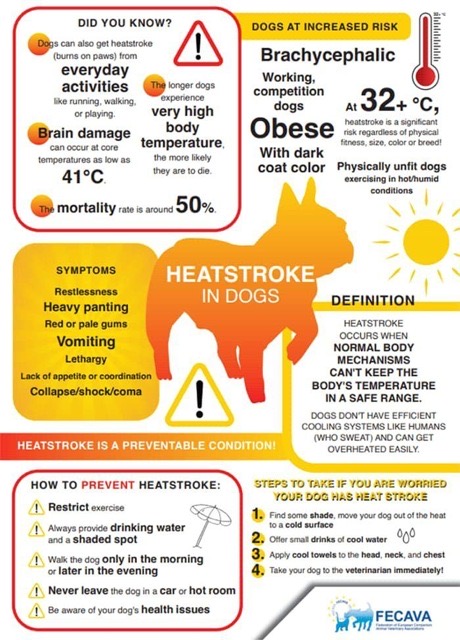Kenzie James
news@greenepublishing.com
Recent heat advisories and heat indexes over 100 degrees Fahrenheit advise people to take precautions to prevent heat exhaustion and heatstroke, but humans are not the only ones at risk of these illnesses. Pets, particularly dogs, are also at high risk of heatstroke during high heat indexes.
The Federation of European Companion Animal Veterinary Associations (FECAVA) recently released an infographic with symptoms, external causes, increased risk factors and how to prevent heatstroke in dogs. Heatstroke is life-threatening for dogs and happens because dogs overheat easily because they do not have efficient cooling systems like humans. However, recognizing the signs and following preventative measures helps decrease the chance of heatstroke in a dog.
Dogs can get heatstroke from everyday activities in the summer, such as walking or playing, and get burns on their paws. The American Kennel Club said in an article that dogs can suffer from heatstroke when their internal body temperature reaches over 105 degrees Fahrenheit.
Dogs may be at a higher risk of heatstroke if they qualify for one of the following factors: dark coat color, they are working or competition dogs, obese, brachycephalic or are physically unfit dogs exercising in hot and humid conditions.
Symptoms of heatstroke include skin hot to touch, restlessness, heavy panting, red or white gums, rapid heart rate, drop in blood pressure, lethargy, severe dehydration, lack of appetite or coordination, vomiting and collapse. If a dog shows these symptoms and might have heatstroke, move the dog in the shade, cold surface and well-ventilated area; offer small drinks of cool water; spray or sponge the dog with cool water, focusing on the underside; and immediately take them to the veterinarian. It is important to not immerse the dog in water or use cold water to cool them down.
Heatstroke can be prevented by restricting exercise, providing drinking water and a shaded spot, walk dogs in the morning or later in the evening, not leaving your dog in a hot car or room and awareness of a dog's health issues. The American Kennel Club said that some veterinarians advise that heatstroke is likely to reoccur if a dog has previously experienced it.
This information and more can be found on the FECAVA infographic below or on the American Kennel Club website at https://www.akc.org/expert-advice/health/heatstrokeindogs.

